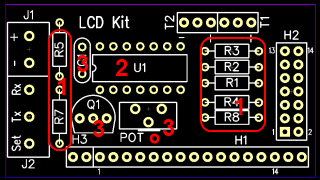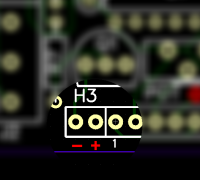
Assembly
Low lying components should be soldered first:
-
start with R1 through R8 (see bellow more information
about R8). -
Then solder the IC socket.
-
Next solder the capacitor, the transistor and the potentiometer.
Use the kit content table to identify the components and the place on PCB.
The header is intended to be mounted on the solder side of pcb.

The LCD is driven in 4 bit mode.
A short video tutorial is presented below:
Pin diagram (H1, H2), LCD connections:
|
Pin |
Function |
Pin |
Function |
|
1 |
Vss |
8 |
Not connected |
|
2 |
Vdd |
9 |
Not connected |
|
3 |
Ve |
10 |
Not connected |
|
4 |
RS |
11 |
Not connected |
|
5 |
R/W |
12 |
DB5 |
|
6 |
E |
13 |
DB6 |
|
7 |
DB0 |
14 |
DB7 |

H3 is reserved for optional piezo speaker or other loads. If a inductive load is driven then a flyback diode must be connected to pins 15 (K) and 16 (A) of H1.
The current available at H3 is limited by R8.
This is provided as
a 0R link and should be sized according to your application.
The maximum current that can be switched by the transistor is 500
mA.
T1 and T2 are reserved for future development.
Tips & tricks
If the unit is intended to be used with more that one LCD type is highly recommended to use socket headers (not provided).
Also, if the unit is used in more that one application then is strongly recommended to use connectors (not provided).
As most of LCD's require the contrast voltage (Ve) close to 0V is recommended to turn the potentiometer fully clockwise before testing the unit.
Testing
Once all components are soldered, insert the IC into socket. Connect Set to ground (-) and power the device with 5V DC. The firmware version should be displayed.